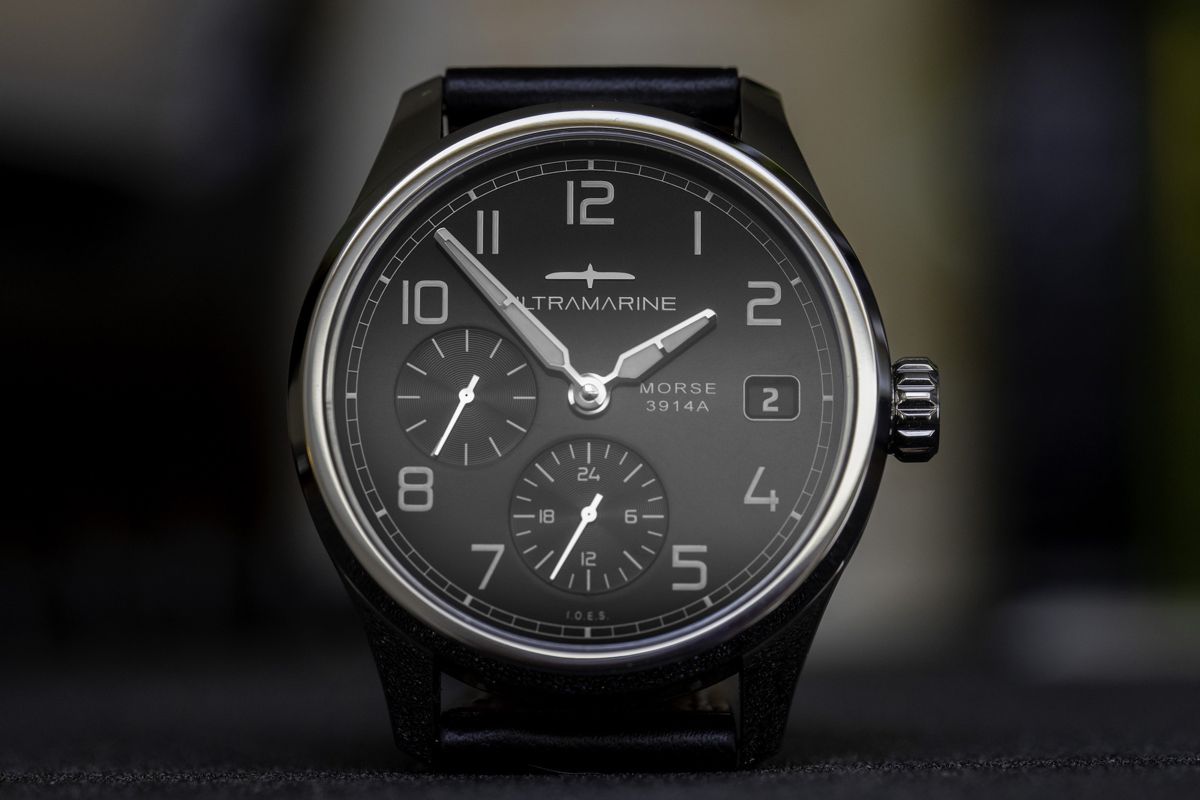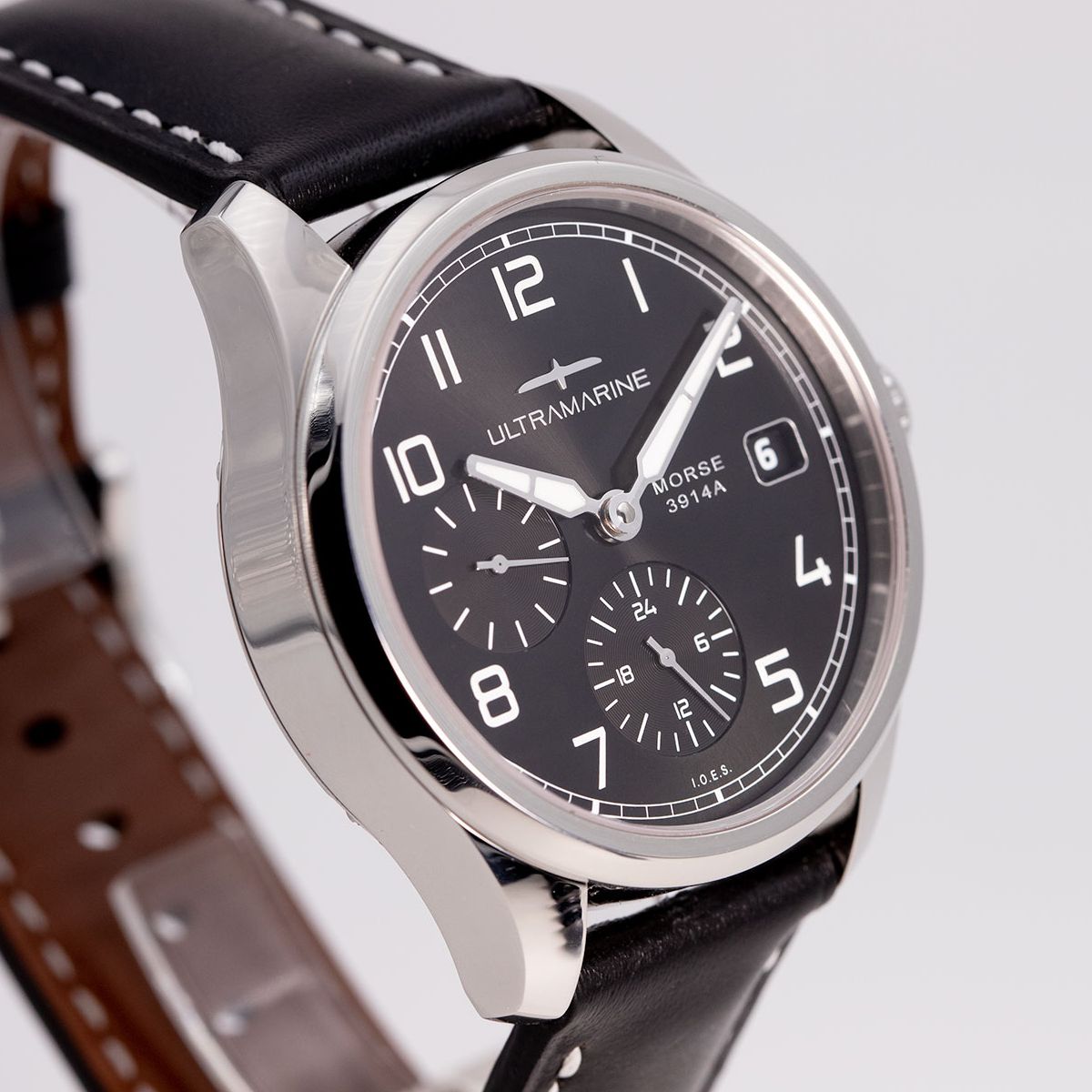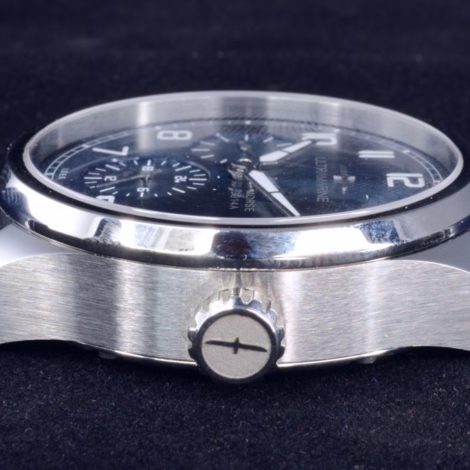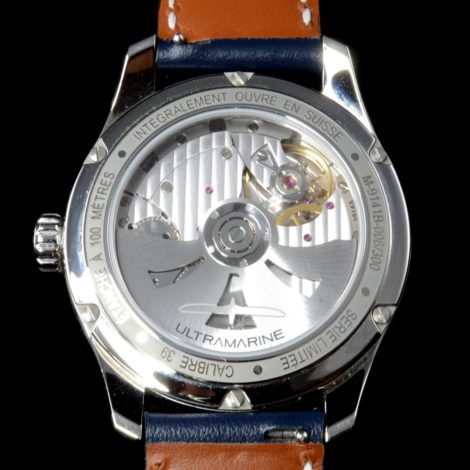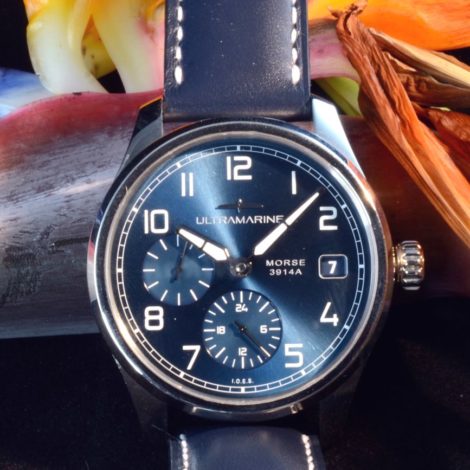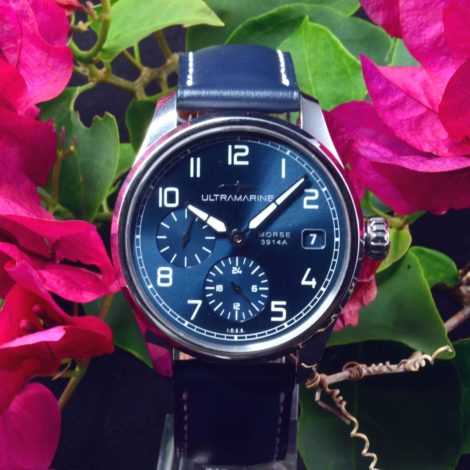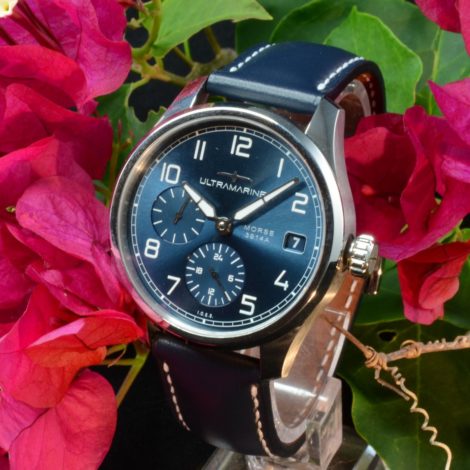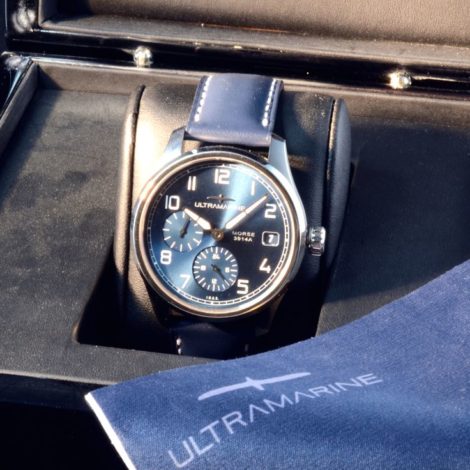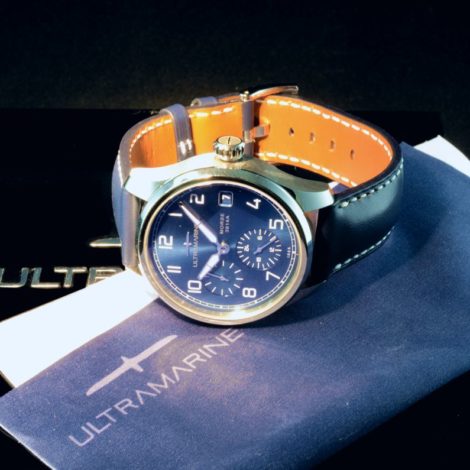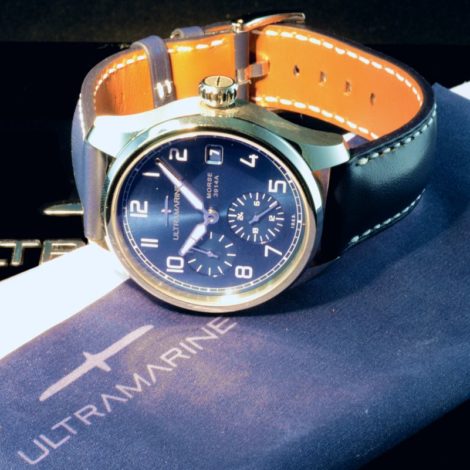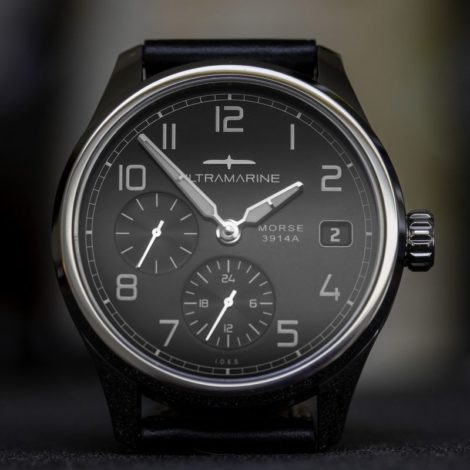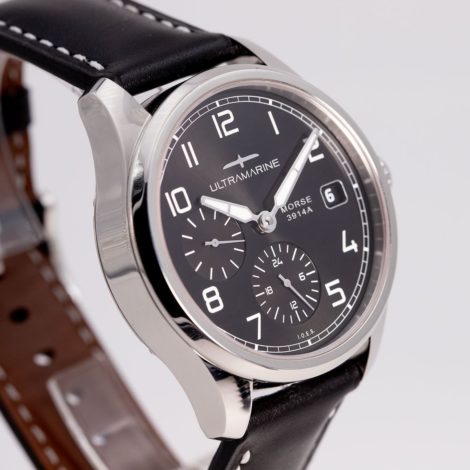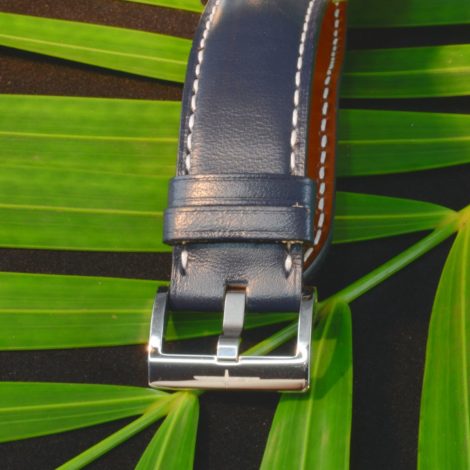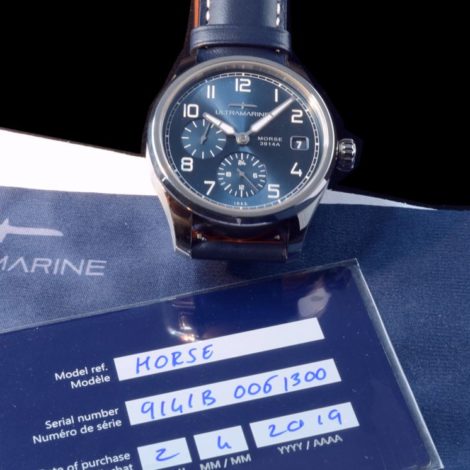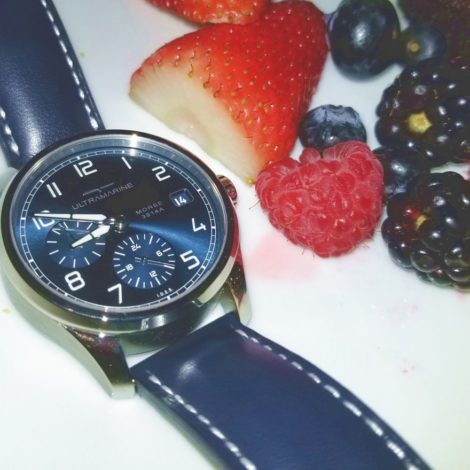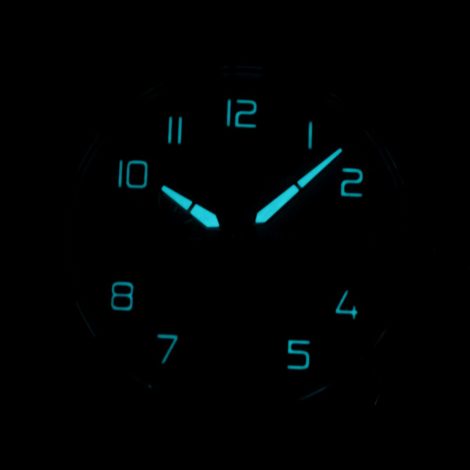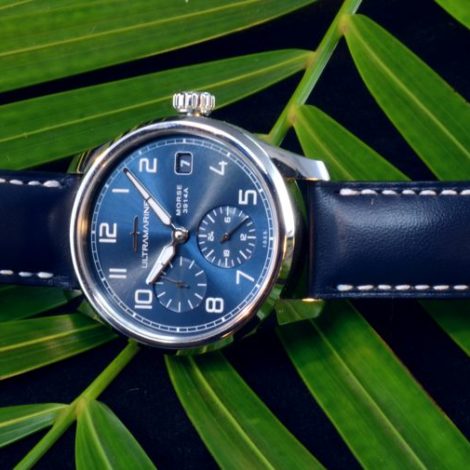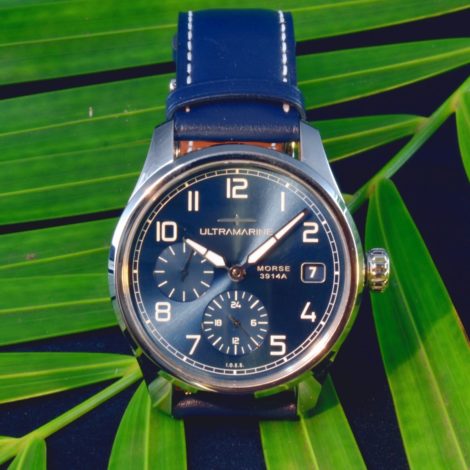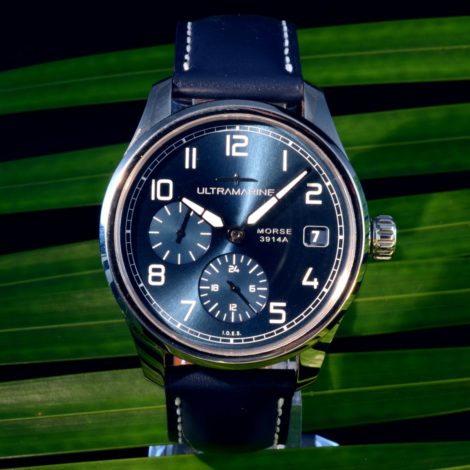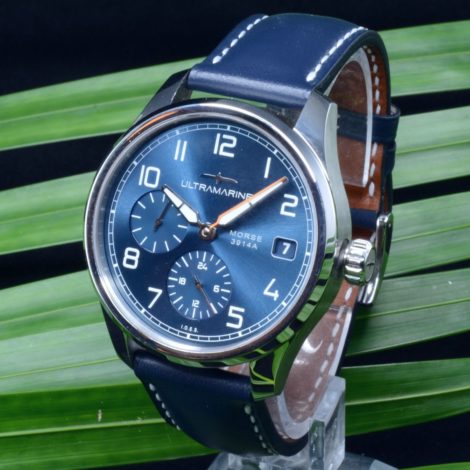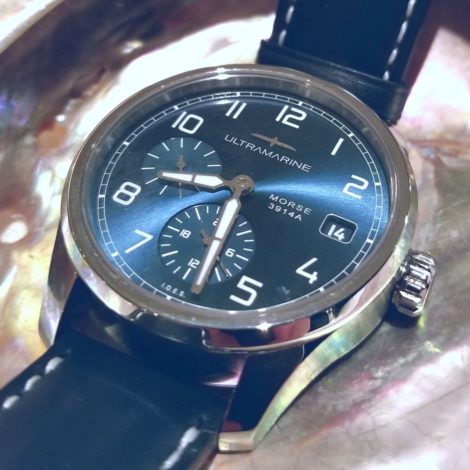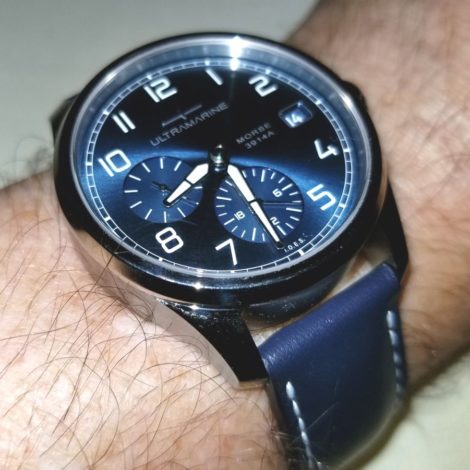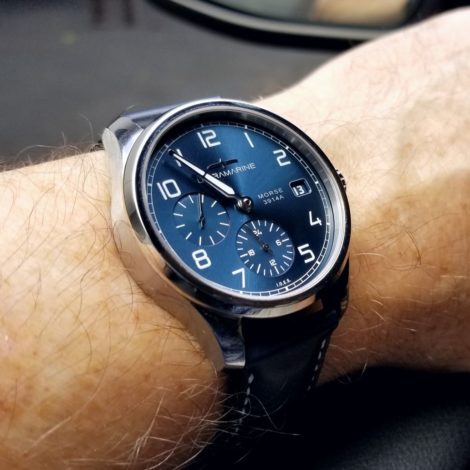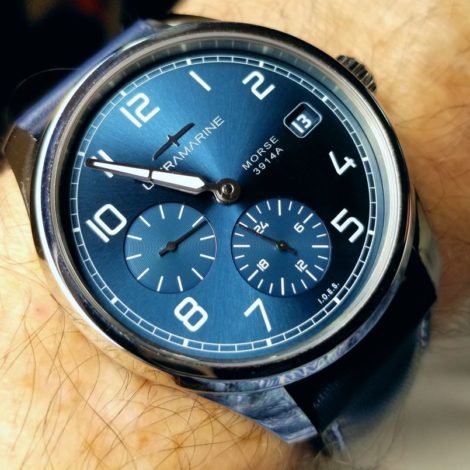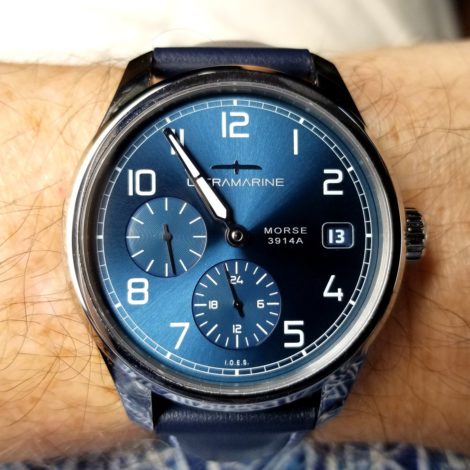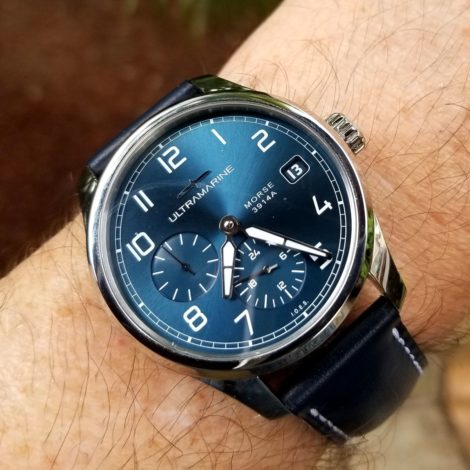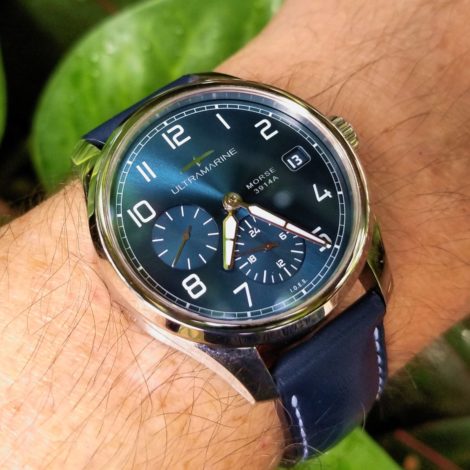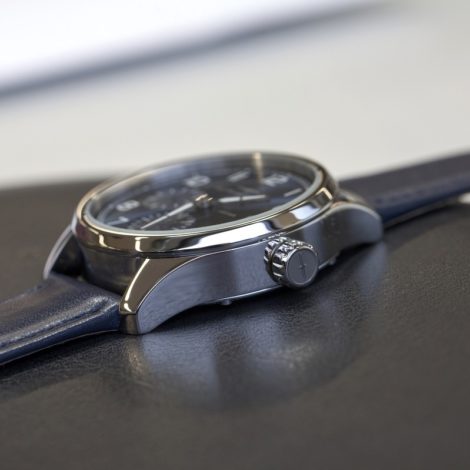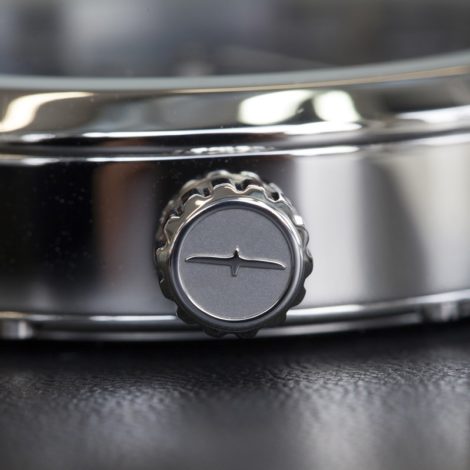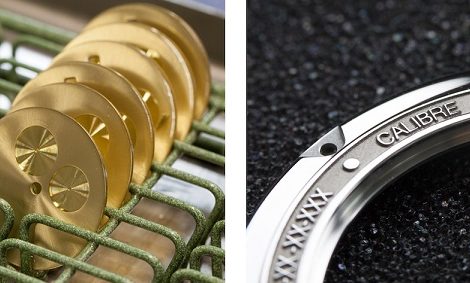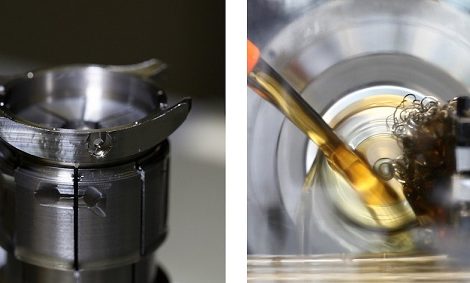 Disclaimer: I purchased an Ultramarine Morse, and the reviewed watch is the one I own. I signed up to buy a Morse back in June 2018 when it was first offered on Kickstarter and was covered via a Sponsored Post on aBlogtoWatch.com. When Kickstarter did not generate enough pre-sales, Lionel of Ultramarine decided to do his own direct-order system, which worked out better. I purchased my watch last Fall at the pre-order price, not the current retail price.
Disclaimer: I purchased an Ultramarine Morse, and the reviewed watch is the one I own. I signed up to buy a Morse back in June 2018 when it was first offered on Kickstarter and was covered via a Sponsored Post on aBlogtoWatch.com. When Kickstarter did not generate enough pre-sales, Lionel of Ultramarine decided to do his own direct-order system, which worked out better. I purchased my watch last Fall at the pre-order price, not the current retail price.
Finding an affordable dual time zone (GMT) Swiss watch that doesn’t use an ETA 2893 (which can only be adjusted forward in whole-hour increments) results in pretty limited choices that often end up looking like a poor rendition of a Rolex Explorer (orange or red triangle tipped 24 hour hand, etc.). The Ultramarine Morse checked these boxes, which I pre-ordered about six months ago and received about a month ago, so I have one of the first production watches (serial number 6), and I think it was worth the wait.
Dial and Hands
Following the current global fashion/passion for blue, the reviewed watch is the blue version, which has a lovely sunray blue dial and matching blue leather strap. The other version has a classic black dial (also with a sunray finish) and strap. The Ultramarine Morse is available in limited editions of 300 in each colorway.
The modern font used for the hour numbers (nine of them — the 3, 6 and 9 go missing, due to the date and sub-dials) combined with classic railroad chapter ring yields an easy-to-read dial and a style what won’t seem dated in the years to come. Above the mark “ULTRAMARINE” is the brand’s logo, which represents a Great Albatross (yes with two ‘s’ in English) — an imposing marine bird with a more than 11-foot wingspan! At 3 o’clock is the date, while the independent 24 time indication (GMT, if you like) is the register at 6 o’clock. Finally, you have the running seconds hand at 9 o’clock. The baton indices on the running seconds are not numbered, but really most of us can figure out the seconds without any numbers.
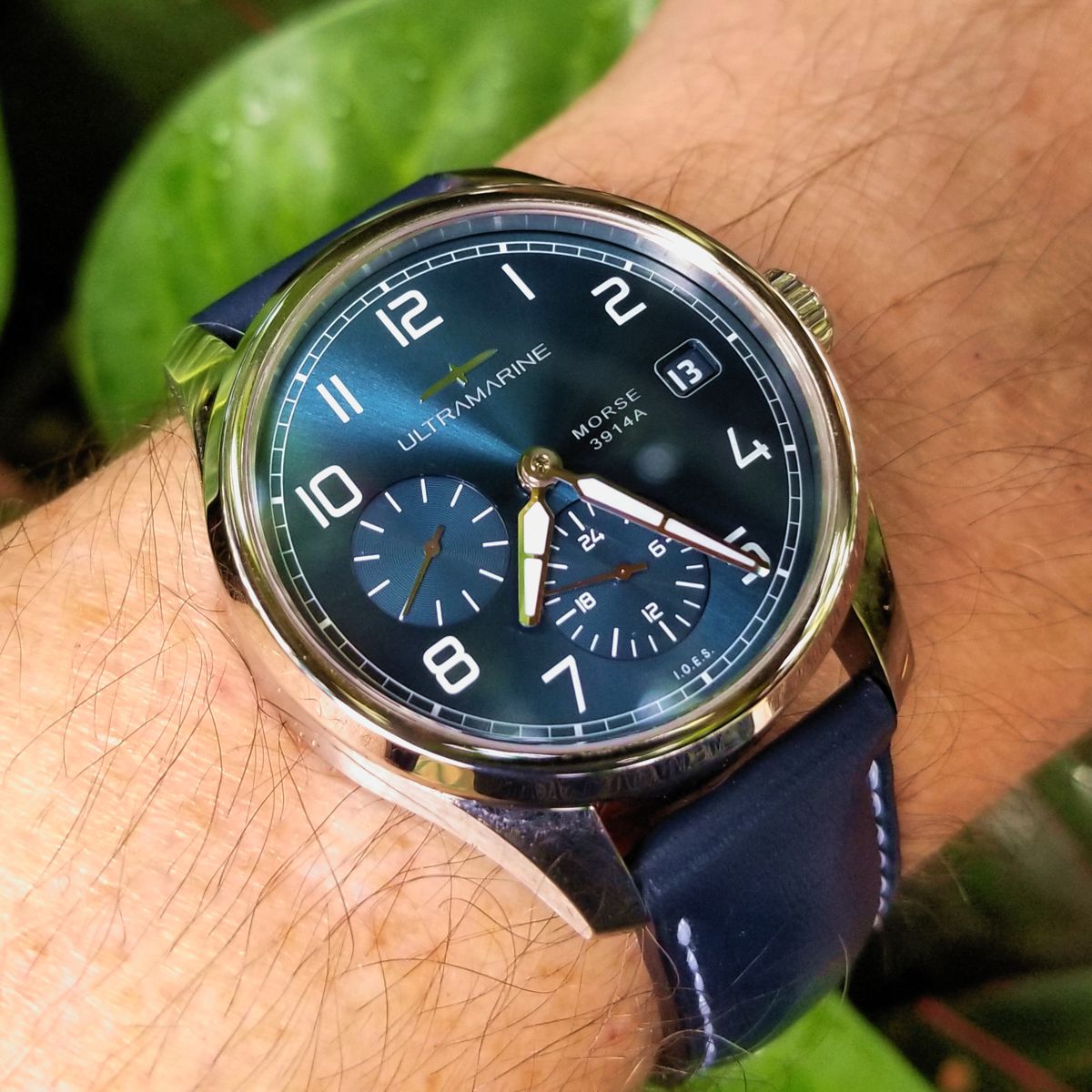
The 24 hour/GMT register also did not have any numbering in the original design, which looked very clean. However, a number of people gave Lionel Bruneau (the founder of Ultramarine) feedback that some numbering would help. Since Bruneau listens to his customers, he decided to add numbers at six-hour intervals. I will admit to having posted a mock-up with numbers in the comments section of the original post here on aBlogtoWatch.com. Bruneau had already had done the design work for the sub-dial numbers for another watch design. So, while I’d like to claim I helped with the design, I really I just helped to confirm that his alternate design was the popular choice.
The hour and minute hands are very legible in all conditions. They are the proper length (yea!) and proportions. The BG W9 Super-LumiNova glows brightly and is blue/green in the dark. The nine hour numerals are also lumed and are as bright as the hands (which is not the case on many watches). A side note: You can photograph any watch’s lume to look great with a long enough exposure. So, unless you photograph multiple watches together for comparison, you have to rely on your own eyes (or the word of a reviewer) on the strength of any given watch’s luminant. The below lume photo was done at f25 with a five- second exposure and was not adjusted in any way.
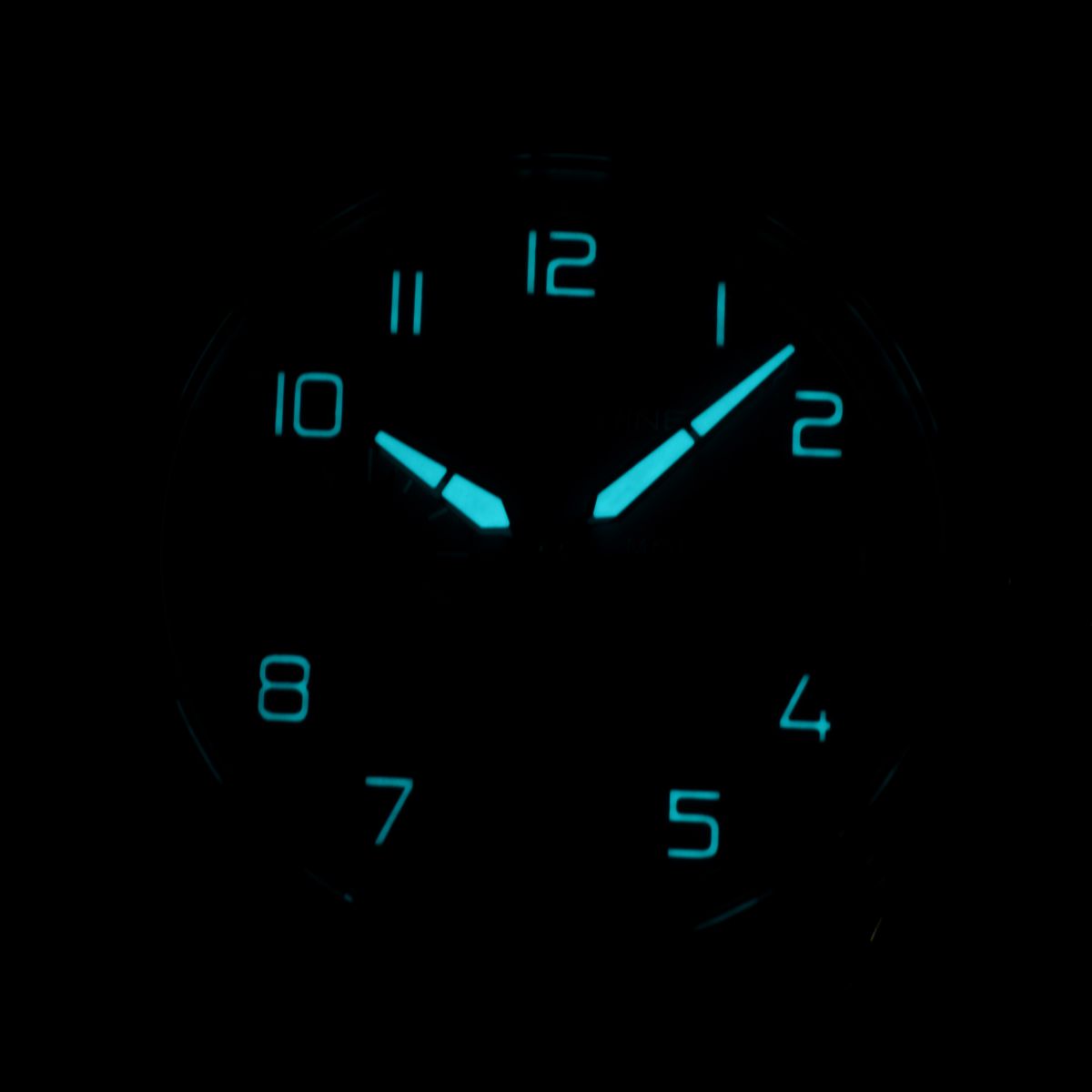
Then there are the register/sub-dial hands that are silver, reflective and have no luminant. They are easy enough to view at some angles but invisible against the dark blue dial at others. But if you just rotate your wrist a little, the running seconds and 24/GMT hands appear. So, while they could have been painted white (instead of being plated a silver finish) or lumed, I would have made the same choice if I were designing the watch, as the silver finish complements the rest of the design. If the hour and minute hands had no lume, this would be a major malfunction, but they do, so it works out well for telling the time of day at a glance. Checking the running seconds or second time zone requires a closer look, so sometimes needing to change my viewing angle is not a real problem.
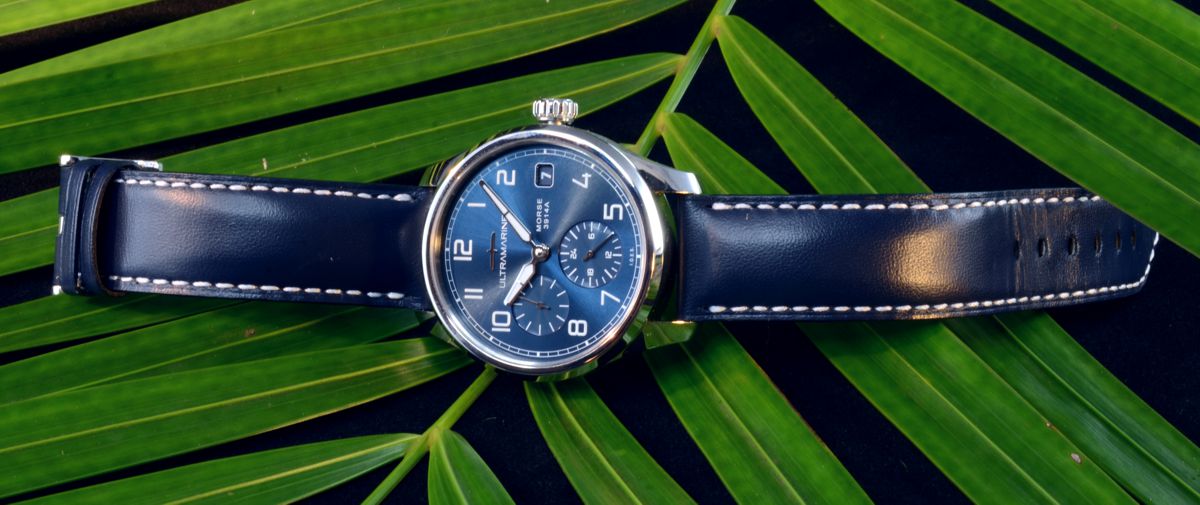
The dial has “snailing” on the running seconds and 24 hour registers, a nice contrast to the overall sunray dial finish. The date window has rounded corners and is outlined in white, while the date wheel has a matching blue background and white date numerals. These kinds of details are what set this watch apart in the sea of watches where we watch geeks usually gripe about date wheels with mismatched color or fonts that clearly don’t match the hour numerals. Not the case here where all of the text/numbers look cohesive (even though the Ultramarine logo at 12 o’clock and the “Morse 3914A” markings at 3 o’clock use different fonts, they work well together).
Notice the “IOES” on the dial? Instead of the usual “Swiss-Made” marking (which this watch more than qualifies for), it is marked as being entirely Swiss-Made, in contrast to just meeting the minimal 60% Swiss content needed to use the internationally trademarked “Swiss-Made” moniker. IOES stands for “Intégralement ouvré en Suisse,” which translates to “fully manufactured in Switzerland.” The final assembly is in Neuchâtel, which has historically been a center of Swiss horology.
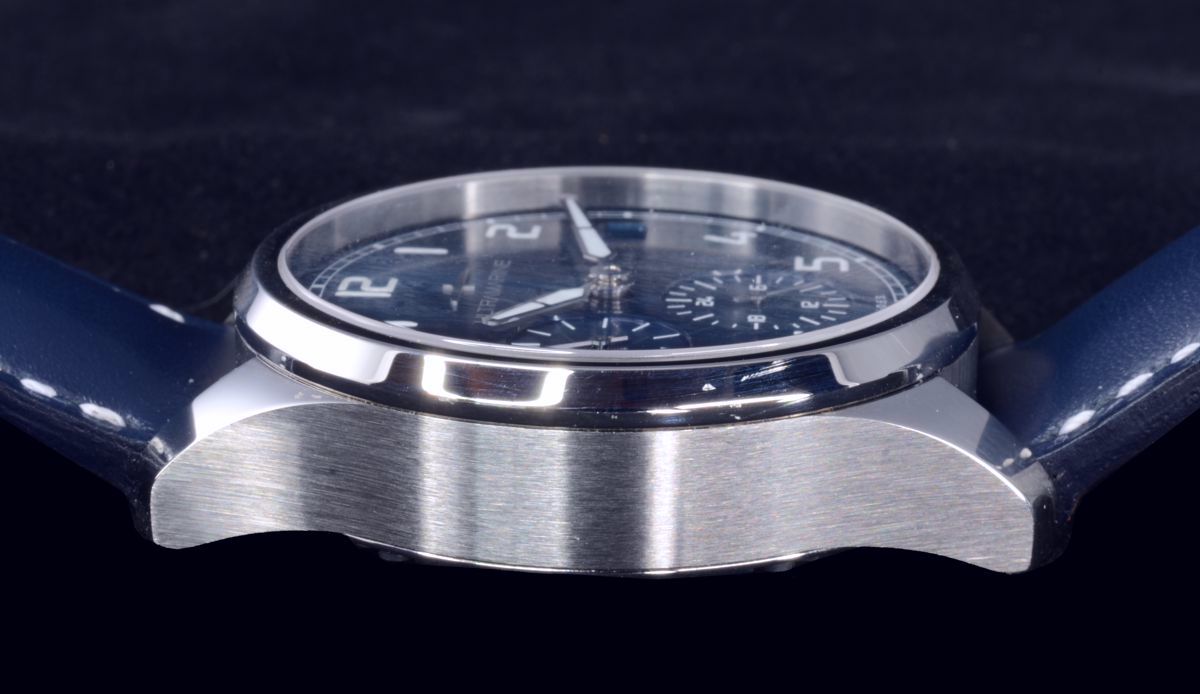
Case
The 316L (surgical) stainless steel case is available in either full polish or a mixed brushed/polished finish. I love the highlights of full polish combined with the modern (and more subtle) look of brushed surfaces, so I ordered the mixed finish. Please excuse the fingerprints and grime on the case in the photos; I’ve been wearing this watch at least half of the time this past month because it’s a great “everyday” watch.

The Eterna Caliber 3914a is 5.60 mm-thick and has a hand fitting height of 2.20 mm, all of which means it’s hard to make a watch with 100 meters of water resistance much thinner using this movement. Really, 12.55 mm is not that thick, however, the case looks to be all of that height. In other words, it looks taller than it is. Part of that visual effect is that the watch is just 40+ mm-wide (so the vertical/horizontal aspect ratio comes into play). It looks a little bit chunky from the side, but it really isn’t that thick.
The case measures 43.5mm-wide with the crown, 12.55m-thick, and has a lug-to-lug of 47.9mm.
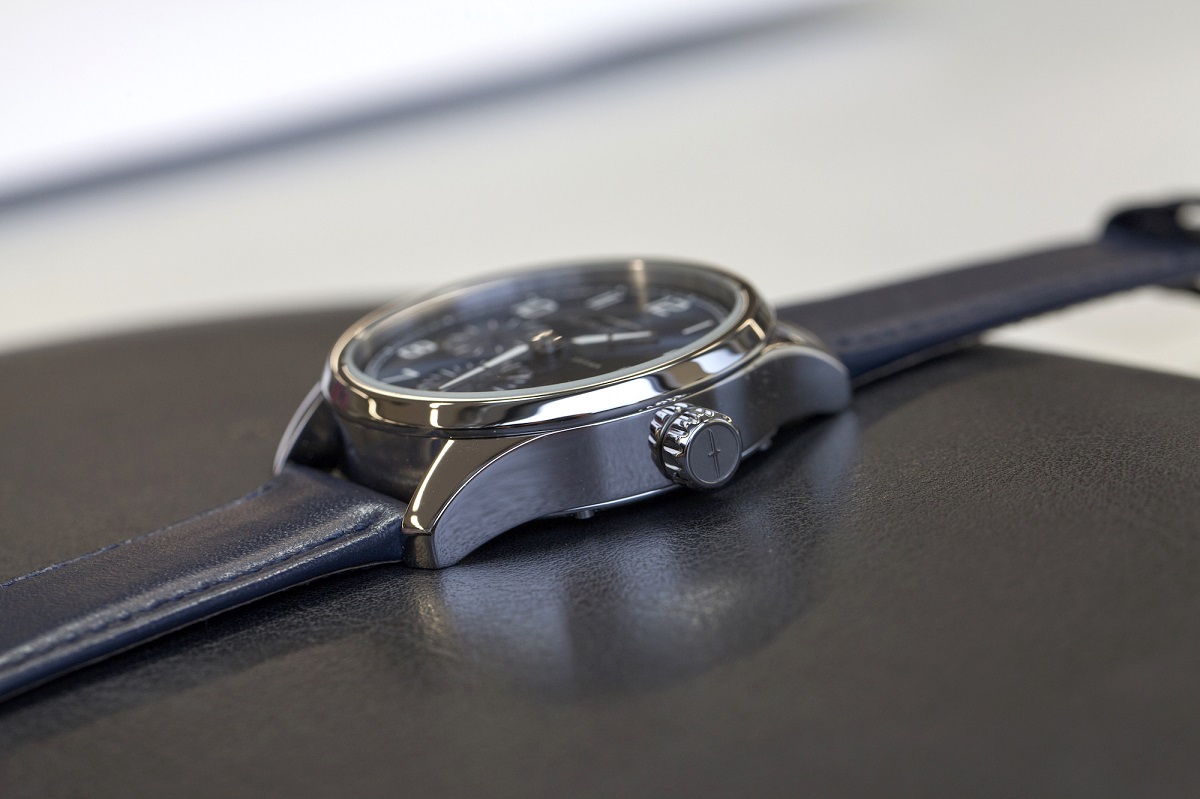
The crystals, top and bottom, are sapphire. The top crystal has anti-reflective coating on the inside. The caseback shows the individual serial number (I’m proud to have #6) circling the back sapphire crystal which shows off the Eterna Caliber 3914a movement. The custom-winding rotor is another item for which Bruneau solicited input from his initial customers during the final development of the Morse. The issue was having a more skeletonized rotor (which was even more attractive) but which would have less mass and would have reduced winding efficiency, effectively reducing the 65-hour power reserve from automatic winding alone. The consensus was that looks are less important than maintaining winding efficiency, so the highly skeletonized rotor was nixed.
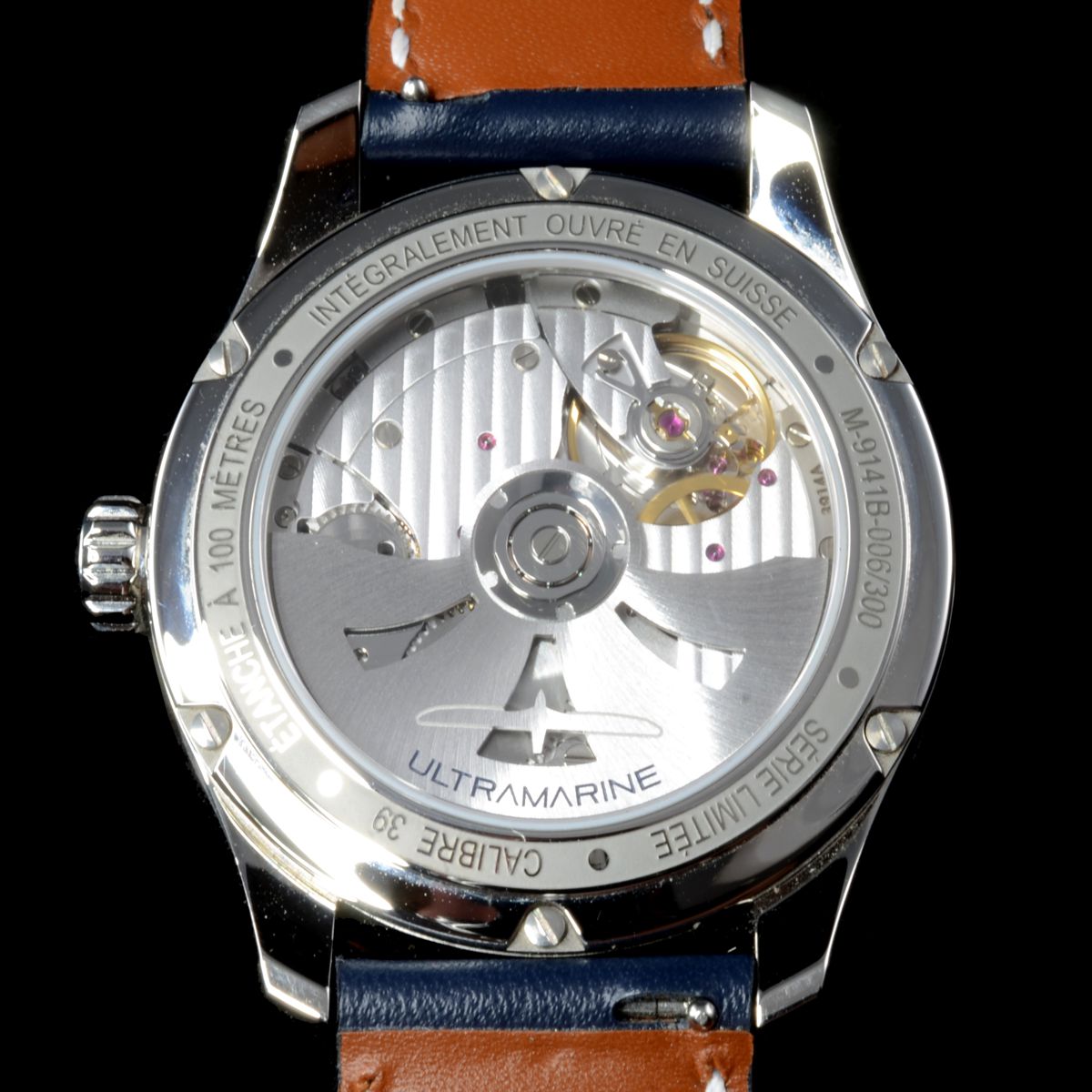
The Movement
The Eterna Caliber 3914a supports a “GMT” time display via an independent 24-hour hand on the register at 6 o’clock. What is great is that you can adjust the 24-hour hand either way and not just in whole-hour increments. For those who vacation in places like Goa, India, but live in whole hour time zones like Scotland, this is the hot ticket. The bi-directional 24-hour hand adjustment makes for convenient adjustments while traversing time zones. Not all GMT movements are that great for travelers, to be honest (ETA 2893, I’m looking at you). The Eterna Caliber 3914a runs at 4 Hz (28,800 vph) and hacks (I pulled the crown out to this stop-seconds position for many of the photos) and has it automatic winding and date indication.
The register/sub-dial at 9 displays the running seconds. For me, the Eterna Caliber 39 was a major factor in deciding to buy this watch. Besides the GMT function, the movement has a 65-hour power reserve, so it is really is a watch you can take off Friday evening and still have running on Monday morning. But it is a great watch to wear over the weekend, as it is essentially a tool watch but one that has refined looks suitable for an evening out. While obviously not a dress watch (a bit too thick for that), it’s entirely appropriate for office wear, whether you work in jeans or a suit.

Since I rotate wearing this watch with my other watches, I’m pleasantly surprised to find this beauty still running even after a day or two in the watch box. I’m so used to picking up a watch in my modest collection and immediately winding and setting it before strapping it on. No need to do that with this Ultramarine Morse, since it ticks along for just under three days, and I wear it often enough that I almost never have to set the time. I do wind it when I put it on, but that’s more of a habit than anything else. Interacting with a mechanical watch is more appealing to me than the couple of quartz watches I still wear.
Your mileage may vary, but here are my timing results for my Morse:
| Timing Results – Eterna Caliber 3914a | |||
|---|---|---|---|
| Position | Sec/Day | Amplitude | Beat Error |
| Face Up | +2 | 276 | 0.0 |
| Face Down | -6 | 275 | 0.1 |
| Crown Right | +2 | 257 | 0.2 |
| Crown Up | -4 | 260 | 0.1 |
| Crown Left | -7 | 259 | 0.1 |
| Crown Down | -3 | 275 | 0.1 |
| Variation | 9 | 19 | 0.2 |
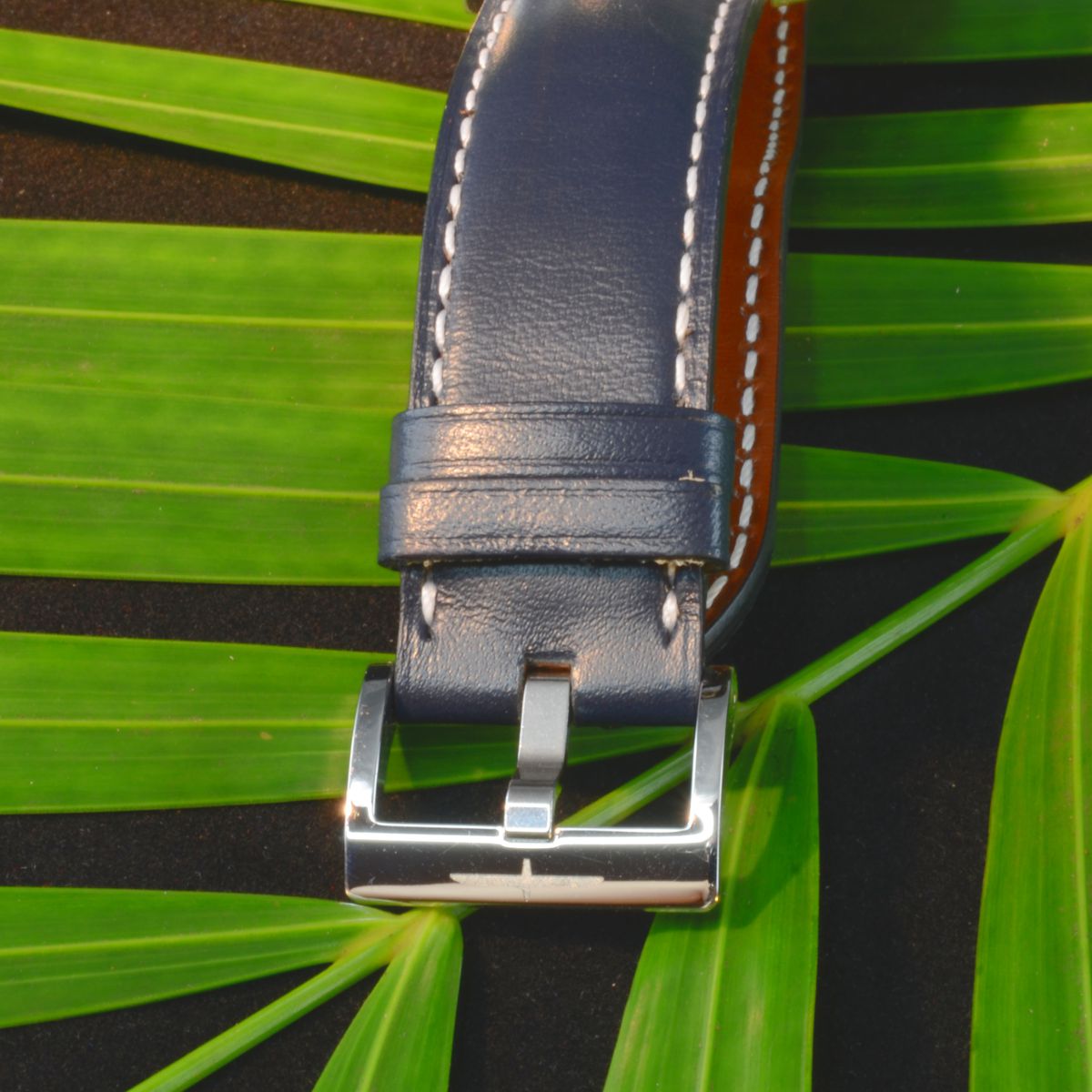
Strap and Buckle
Since I ordered the blue dial reference, my Morse came with a blue leather strap (the black dialed ones come with a black strap). And there are other strap color choices available as well. The strap on mine is navy blue on top and an brownish orange color on the inside. The white-contrast stitching works well with the white chapter ring on the dial, to my mind. The pin buckle has the Ultramarine Albatros logo as a hallmark. As a rule, I put deployment buckles on the watches I wear a lot, as this reduces wear on the strap at the buckle.
So I was half expecting the surface of the strap on this Morse to show signs of wear, cracking, etc. So far, I’m pleased to report that the strap is breaking in nicely and has softened up a bit at the buckle but has not cracked at all. Down the road, I may put a third-party deployment buckle on this watch, but then I’d have to remove the albatross logo’ed buckle (sigh… always a trade off). In short, the strap is higher quality than is often found at this price point and also features quick-release pins for tool-free removal. Again, attention to details like the quick release pins make this a satisfying watch to own and wear.

The Brand
Lionel Bruneau designed the Morse and the Albatross watches as a passion project (something I clearly identify with). While Bruneau is based in France, he maintains a close working relationship with the manufacture in Neuchâtel. Ultramarine also offers its “Albatros” (three-hand) watches for pre-sale via its website. Expected delivery of Albatros watches is Summer 2019. Ultramarine will donate 10% of profits to Non-Governmental Organizations committed to marine protection and conservation. Ultramarine watches are guaranteed for three years, parts and labor.
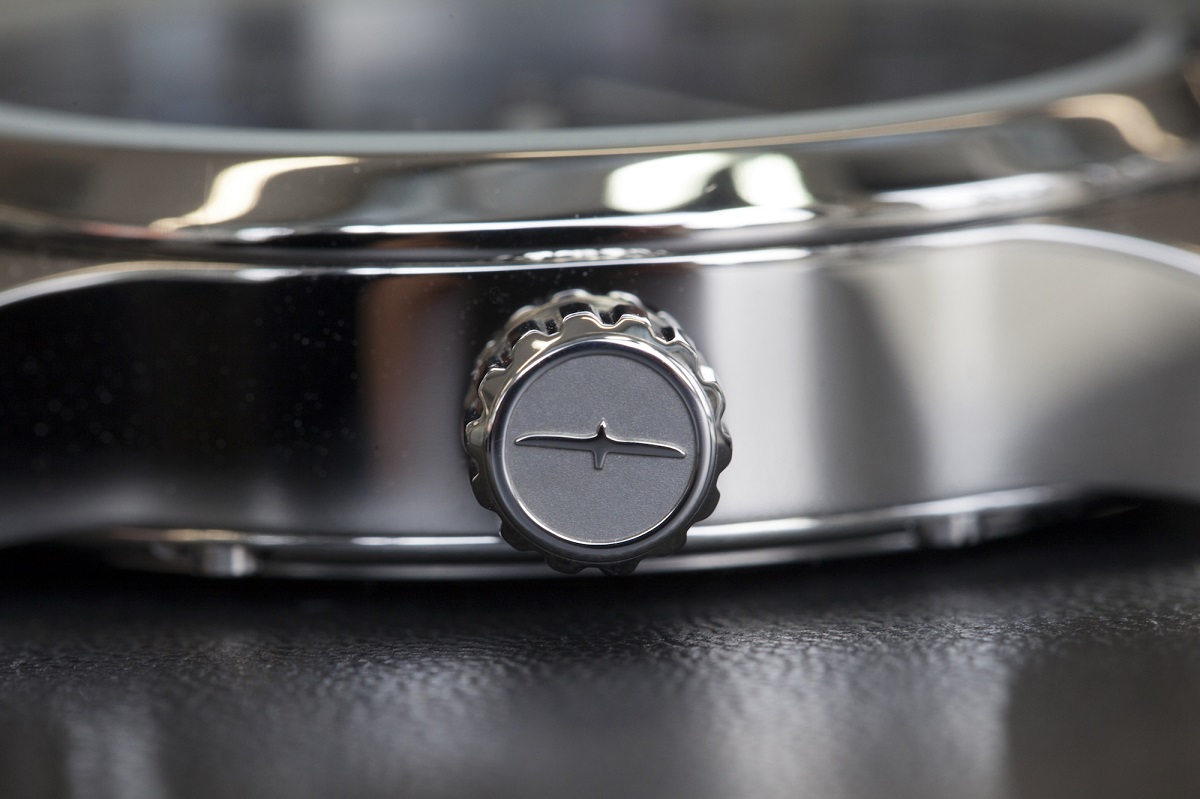
The Bottom Line
Is this watch worth buying and wearing? Well, it is for me. If you fancy a GMT watch that eschews a central hand, this might be the watch for you. The long-running Caliber 39, overall design, and great attention to many details sealed the deal for me. Is this watch perfect? No, but my gripes are limited to the following (and none are deal breakers for me): 1) The chrome hands on the 24-hour and running seconds would be even better even if painted white (or lumed), even though it would look a little bit less classy that way; 2) the crown is normal sized at 7 mm in diameter but still feels a bit small when winding the watch. Either a bit larger diameter or longer length might improve the feel when winding and setting; 3) the inside upper edges of the lugs are rather sharp — no, you won’t cut yourself or anything, but they are not smoothed off like the outer edges of the lugs arehis. This not a wearing-comfort issue at all; I just happen to run my fingers over watches when I’m wearing them.
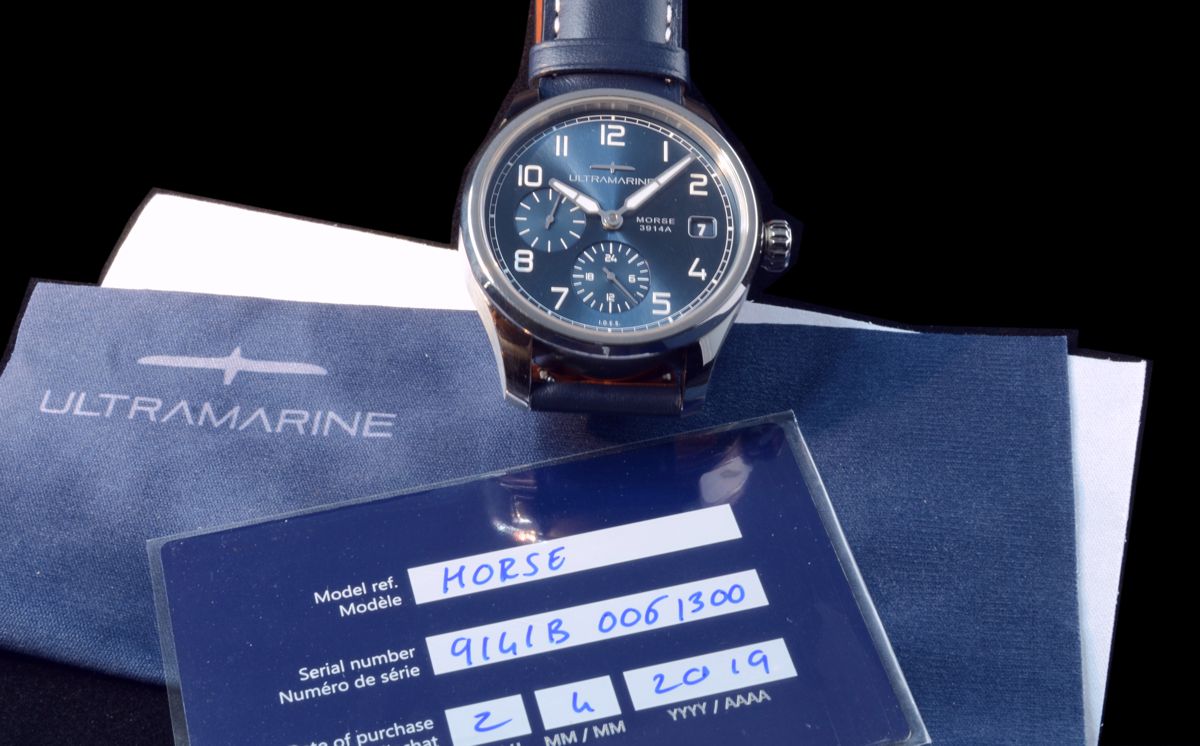
A branded deployment buckle would be nice, but that would drive up the price (as Lionel has high standards and a $15 deployment buckle won’t do for his watches). As for the value proposition, this watch is competitively priced, given the movement and quality of materials used. To be honest, I rarely buy watches (usually I spend my money on developing my own), so a watch has to have a lot going for it to get me to buy it. Support your microbrands of choice if you appreciate interesting designs and fair prices.
The Ultramarine Morse GMT is priced at €1,650.00 (approximately $1,860 USD) and is limited to 300 pieces in blue and 300 pieces in black. You can learn more over at ultramarine-watches.com.

